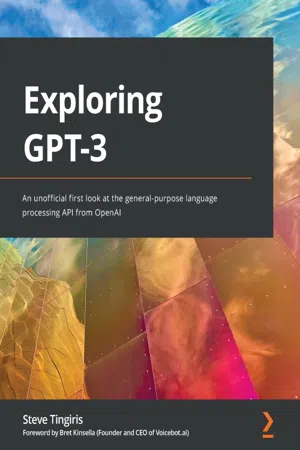
- 296 pages
- English
- ePUB (mobile friendly)
- Available on iOS & Android
Exploring GPT-3
About this book
Get started with GPT-3 and the OpenAI API for natural language processing using JavaScript and PythonKey Features• Understand the power of potential GPT-3 language models and the risks involved• Explore core GPT-3 use cases such as text generation, classification, and semantic search using engaging examples• Plan and prepare a GPT-3 application for the OpenAI review process required for publishing a live applicationBook DescriptionGenerative Pre-trained Transformer 3 (GPT-3) is a highly advanced language model from OpenAI that can generate written text that is virtually indistinguishable from text written by humans. Whether you have a technical or non-technical background, this book will help you understand and start working with GPT-3 and the OpenAI API. If you want to get hands-on with leveraging artificial intelligence for natural language processing (NLP) tasks, this easy-to-follow book will help you get started. Beginning with a high-level introduction to NLP and GPT-3, the book takes you through practical examples that show how to leverage the OpenAI API and GPT-3 for text generation, classification, and semantic search. You'll explore the capabilities of the OpenAI API and GPT-3 and find out which NLP use cases GPT-3 is best suited for. You'll also learn how to use the API and optimize requests for the best possible results. With examples focusing on the OpenAI Playground and easy-to-follow JavaScript and Python code samples, the book illustrates the possible applications of GPT-3 in production. By the end of this book, you'll understand the best use cases for GPT-3 and how to integrate the OpenAI API in your applications for a wide array of NLP tasks.What you will learn• Understand what GPT-3 is and how it can be used for various NLP tasks• Get a high-level introduction to GPT-3 and the OpenAI API• Implement JavaScript and Python code examples that call the OpenAI API• Structure GPT-3 prompts and options to get the best possible results• Select the right GPT-3 engine or model to optimize for speed and cost-efficiency• Find out which use cases would not be suitable for GPT-3• Create a GPT-3-powered knowledge base application that follows OpenAI guidelinesWho this book is forExploring GPT-3 is for anyone interested in natural language processing or learning GPT-3 with or without a technical background. Developers, product managers, entrepreneurs, and hobbyists looking to get to grips with NLP, AI, and GPT-3 will find this book useful. Basic computer skills are all you need to get the most out of this book.
Frequently asked questions
- Essential is ideal for learners and professionals who enjoy exploring a wide range of subjects. Access the Essential Library with 800,000+ trusted titles and best-sellers across business, personal growth, and the humanities. Includes unlimited reading time and Standard Read Aloud voice.
- Complete: Perfect for advanced learners and researchers needing full, unrestricted access. Unlock 1.4M+ books across hundreds of subjects, including academic and specialized titles. The Complete Plan also includes advanced features like Premium Read Aloud and Research Assistant.
Please note we cannot support devices running on iOS 13 and Android 7 or earlier. Learn more about using the app.
Information
Section 1: Understanding GPT-3 and the OpenAI API
- Chapter 1, Introducing GPT-3 and the OpenAI API
- Chapter 2, GPT-3 Applications and Use Cases
Chapter 1: Introducing GPT-3 and the OpenAI API
- Introduction to GPT-3
- Democratizing NLP
- Understanding prompts, completions, and tokens
- Introducing Davinci, Babbage, Curie, and Ada
- Understanding GPT-3 risks
Technical requirements
Introduction to GPT-3
Simplifying NLP
What exactly is GPT-3?
Table of contents
- Exploring GPT-3
- Foreword
- Preface
- Section 1: Understanding GPT-3 and the OpenAI API
- Chapter 1: Introducing GPT-3 and the OpenAI API
- Chapter 2: GPT-3 Applications and Use Cases
- Section 2: Getting Started with GPT-3
- Chapter 3: Working with the OpenAI Playground
- Chapter 4: Working with the OpenAI API
- Chapter 5: Calling the OpenAI API in Code
- Section 3: Using the OpenAI API
- Chapter 6: Content Filtering
- Chapter 7: Generating and Transforming Text
- Chapter 8: Classifying and Categorizing Text
- Chapter 9: Building a GPT-3-Powered Question-Answering App
- Chapter 10: Going Live with OpenAI-Powered Apps
- Other Books You May Enjoy